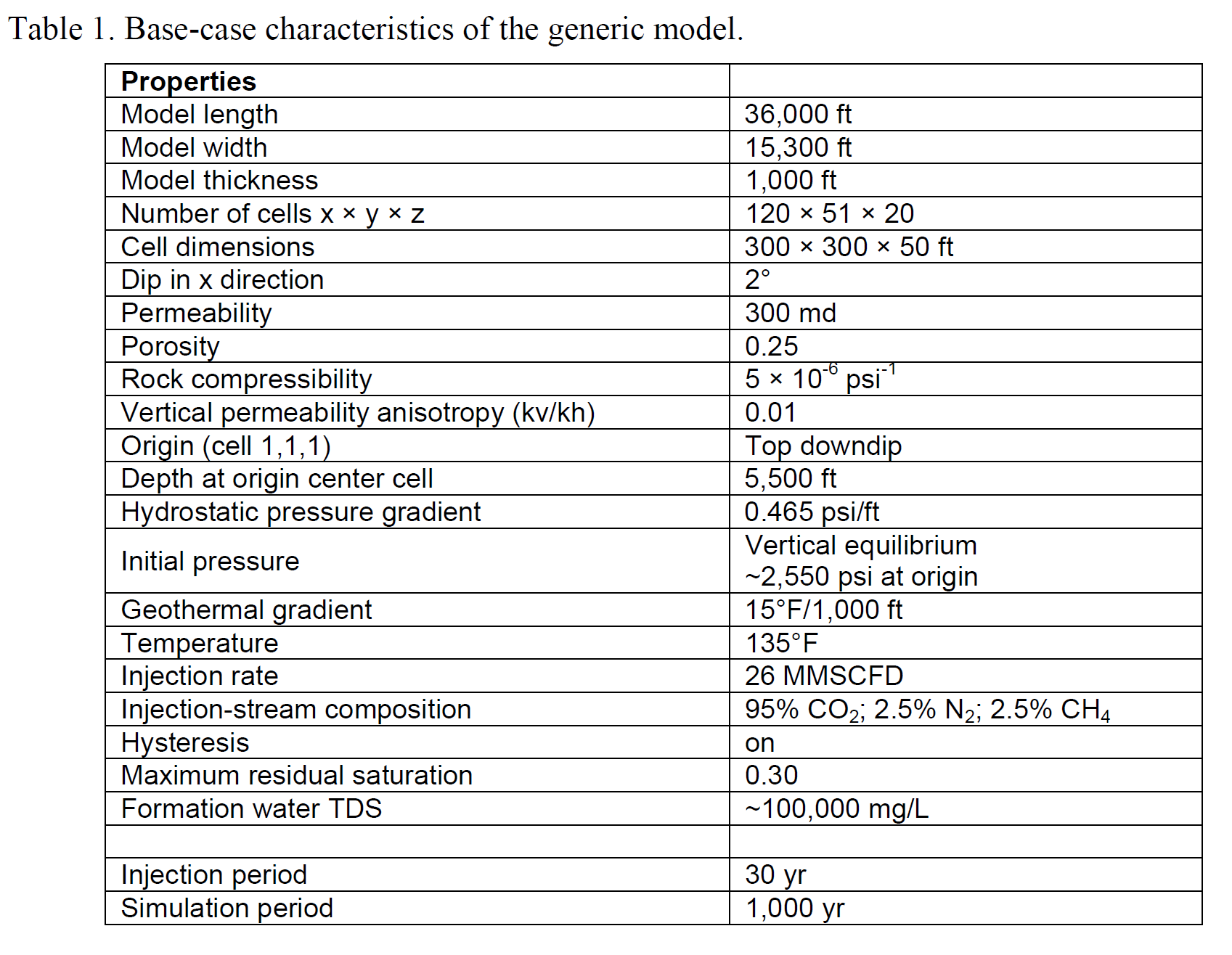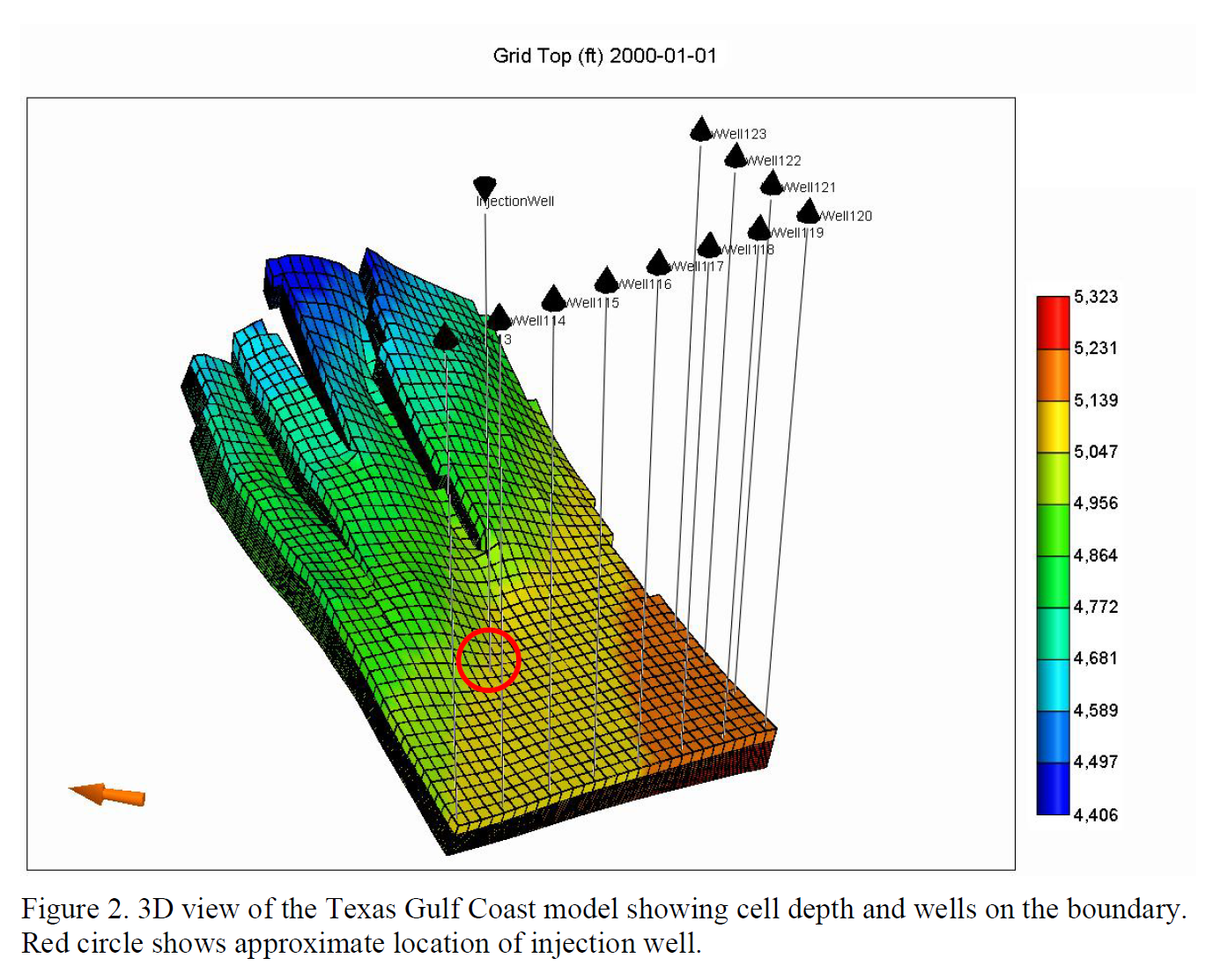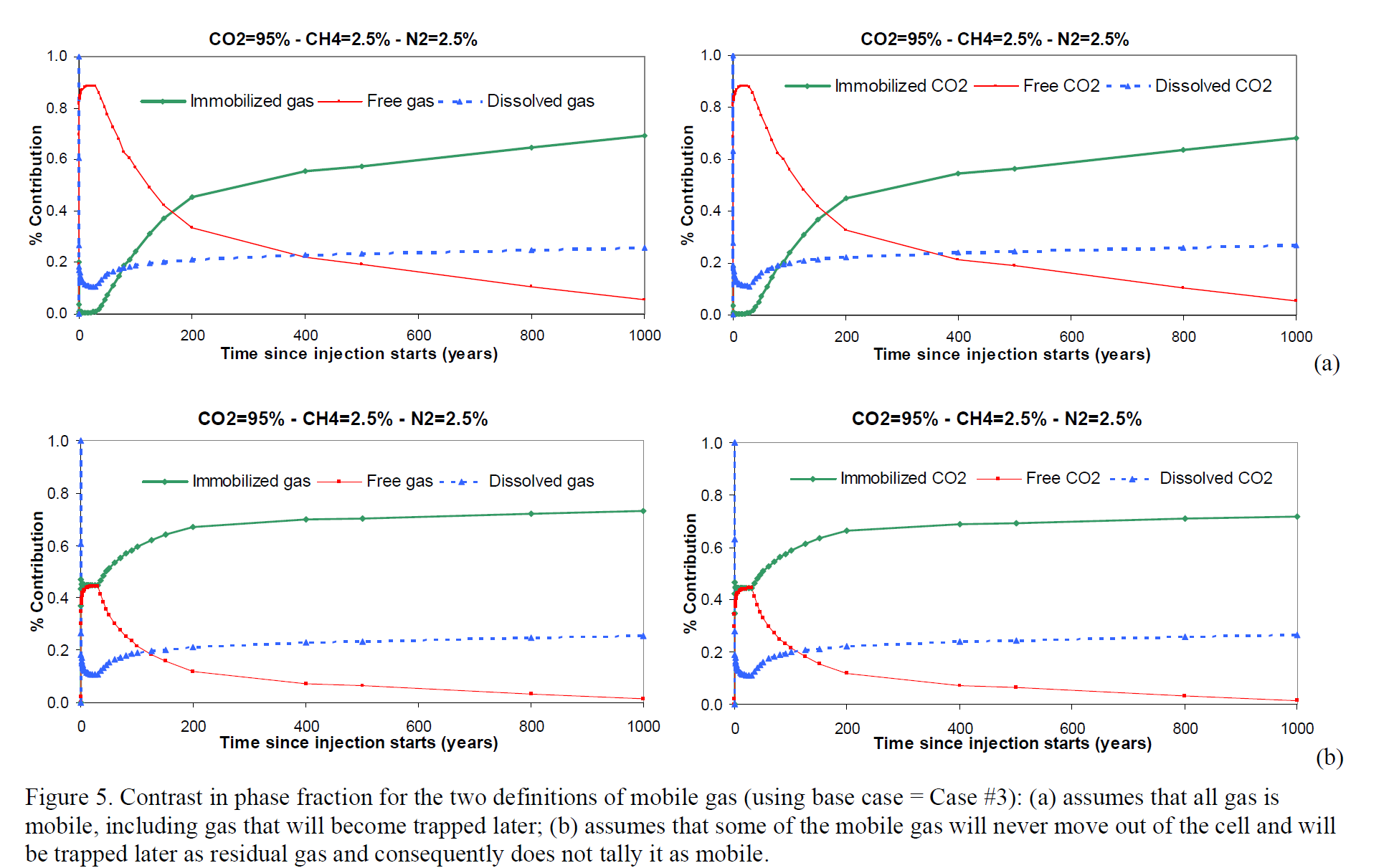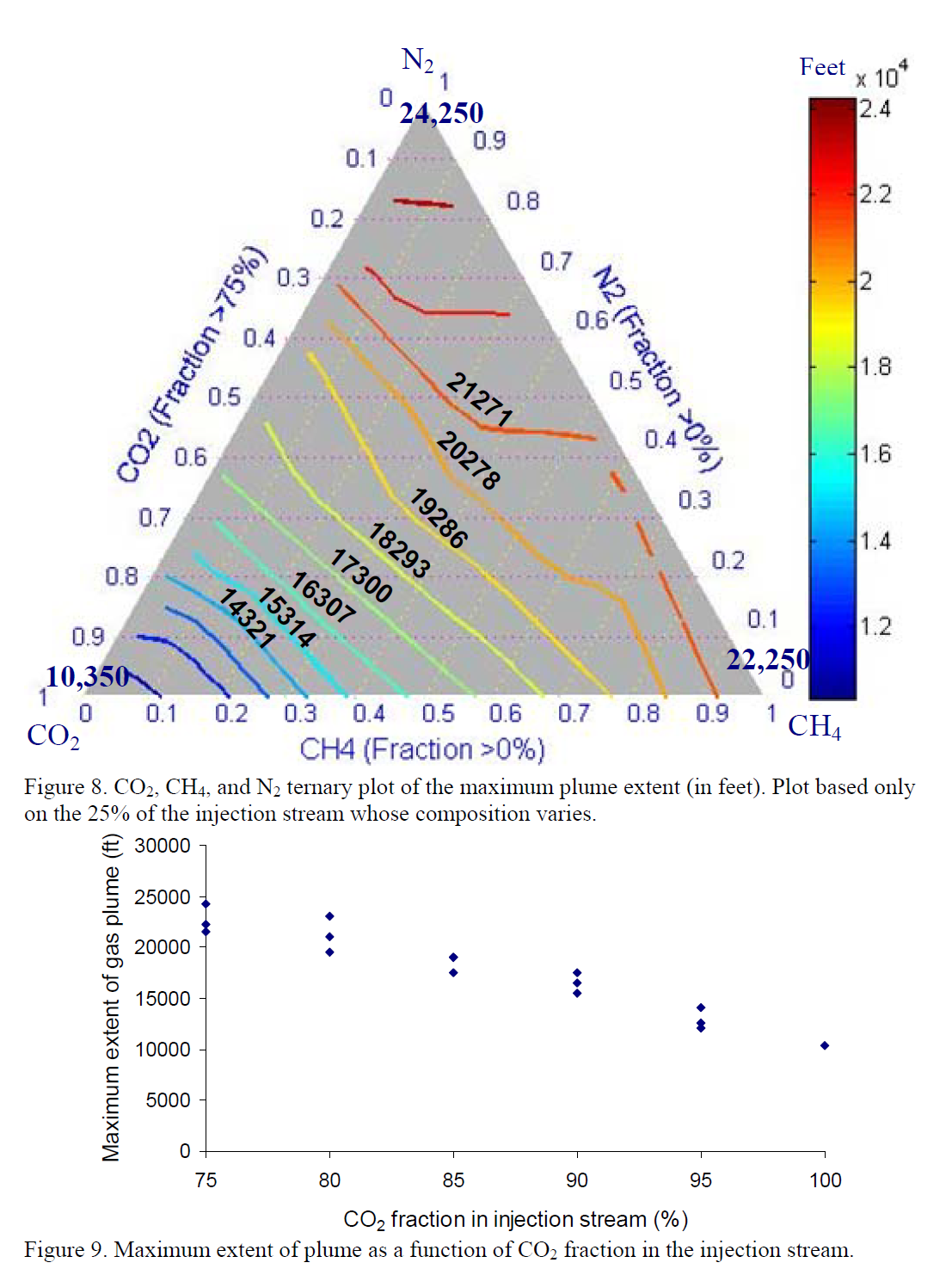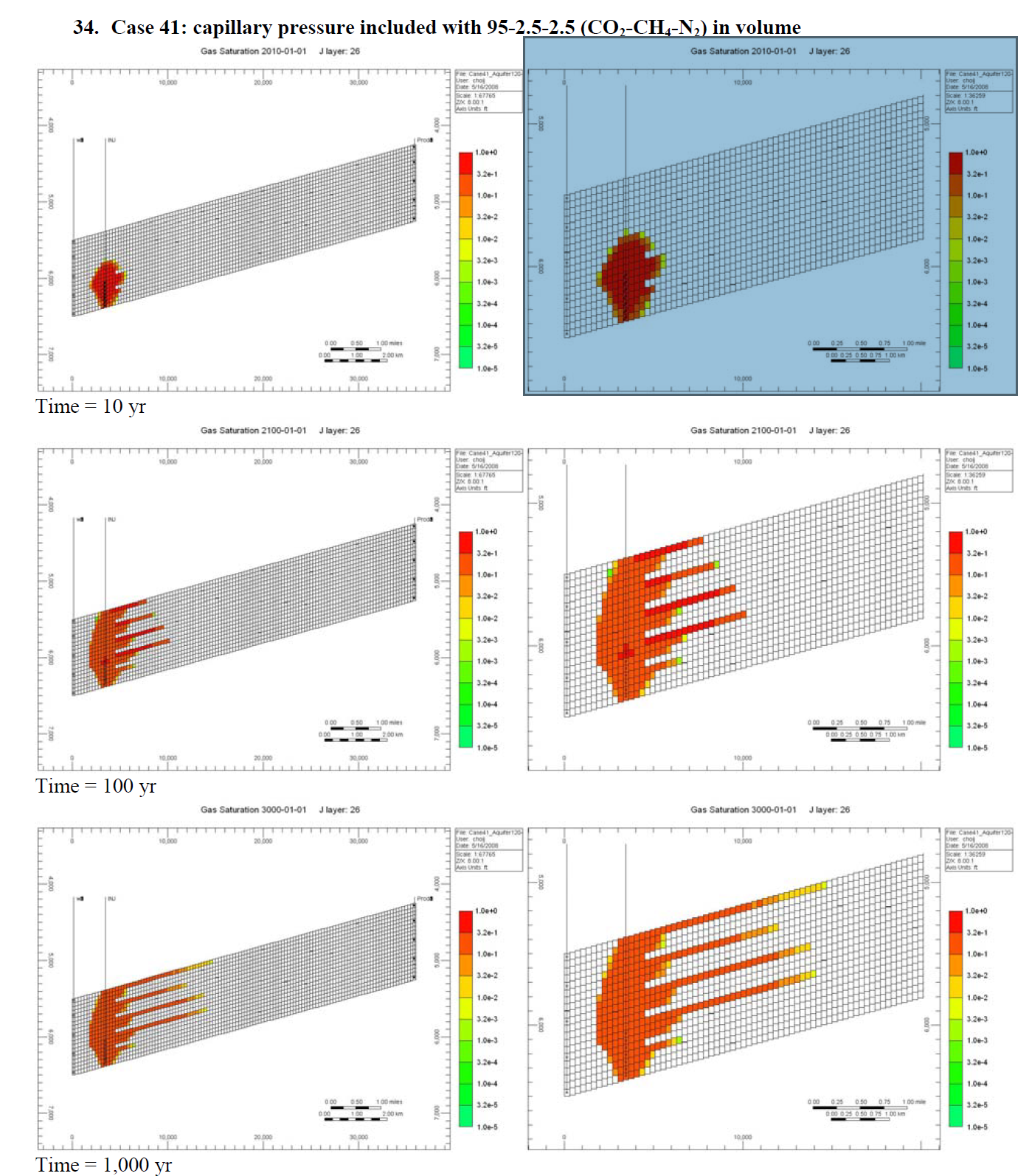Impact of Mixed Gas Stream on CO2 Plume Characteristics during and after Carbon Storage Operations in Saline Aquifers
本研究的目的是解释CO2流体杂质(CH4和N2)对(1)羽流扩散、(2)主要捕集机制的速率和范围、(3)CO2储存容量和(4)井注入能力的影响。注入流体基本情况包括95%CO2流和2.5%CH4和N2。我们将CO2分数从75%变为100%(以摩尔为基础),定义了三种边界情况(BC),CO2边界、CH4边界以及N2边界:分别含有100%CO2、75%CO2和25%CH4以及75%CO2和25%N2。在流体组成的参数研究中,我们定义了一个简单的储层,其平均渗透率为300md,倾角为2°,孔隙度为25%。该模型在倾斜方向包含120个300英尺长的网格,还包括四个与顶部和底部平行的无渗透性隔层。在约6000 ft深度气体以26 MMSCFD(相当于50 Mt/年纯CO2)的速度注入位于模型下倾段井中,注入时间为30年,并在注入地层1000 ft厚度的下三分之一处射孔。温度恒定在135°F。开始注入后,对结果进行1000年的数值监测。模拟使用CMG-GEM软件完成,我们使用了一组用户定义的PVT属性。还对重要模型参数进行了敏感性分析,以评估其相对于参数研究结果的重要性。
该研究仅考虑了两种捕集机理(束缚空间捕集和盐水溶解捕集),这两种机制在很大程度上受注入流体组成的影响。羽流扩散,或最大范围与组成有重要的函数关系。最大羽流范围从CO2BC的10350 ft到CH4BC(22250 ft)和N2 BC(24250 ft)距离的两倍多,中间值大致呈线性变化。同样,羽流到达地层顶部的时间从14年(N2BC)到18年(CH4BC)到60年(CO2BC)不等。气体组分之间的主要差异在于,CO2在盐水中的溶解度大约是CH4和N2的10倍(以摩尔计)。在CH4BC和N2BC情况下,浮力驱动力(表示为气体盐水密度差与气体粘度的比值)也大约高出四倍,并且由于CH4和N2的分数随着CO2溶解而增加,因此该比值一直在增加。
因此,富含CH4-和/或N2的羽流将比单组分CO2羽流传播得更远、更快。在开始注入1000年后,CH4BC和N2BC案例中的所有气体都已固定,尽管CO2BC案例中只有85%。危险的是,这些结果意味着注入中的杂质将有助于更快地固定羽流,但羽流将传播更远。此外,存储容量分析还表明,含有CH4/N2的系统捕集CO2的速度更快。即使注入的二氧化碳较少,这些系统中仍会截留更多的二氧化碳。仅在注入开始后100至200年内,纯CO2系统才能在注入井给定距离内获得更多的非流动CO2。在恒压下,75%CO2和25%CH4或N2混合物的注入总量约为100%CO2气流的80%。对渗透率、孔隙度、倾角和其他参数的敏感性分析表明,注入流体的组成决定了系统的行为。我们还使用了一个典型的墨西哥湾海岸实际现场数据,其模拟结果与一般情况相似,证实了通用模型成功模拟了系统的综合特征。
Summary
The goal of this short study was to explain the effects of CO2 stream impurities (CH4 and N2) on (1) plume spread, (2) rate and extent of major trapping mechanisms, (3) CO2 storage capacity, and (4) well injectivity. The injection-stream base case consists of a 95% CO2 stream with 2.5% CH4 and N2. We varied the CO2 fraction from 75% to 100% (on a mole basis), defining three bounding cases: CO2BC, CH4BC, and N2BC containing 100% CO2, 75% CO2 and 25% CH4, and 75% CO2 and 25% N2, respectively. In a parametric study of the stream composition, we defined a simple generic reservoir with a uniform permeability of 300 md, a dip of 2°, and porosity of 25%. The model contains 120 300-ft-long cells in the dip direction and also includes four baffles with no permeability parallel to its top and bottom. The gas was injected for 30 years at a depth of about 6,000 ft and at a rate of 26 MMSCFD (equivalent to 0.5 Mt/yr of pure CO2) in a single well located in the downdip section of the model and perforated in the lower third of the 1,000-ft thickness of the injection formation. Temperature is constant at 135°F. Results are numerically monitored for 1,000 yr after start of injection. The modeling was done using CMG-GEM software, and we used a user-defined set of PVT properties. A sensitivity analysis on important model parameters was also done to assess their importance relative to the parametric-study results.
The study considers only the two trapping mechanisms (residual saturation and brine dissolution) largely impacted by injection-stream composition. Plume spread, or maximum extent, is a strong function of composition. The maximum extent ranges from 10,350 ft for CO2BC to more than twice the distance for CH4BC (22,250 ft) and N2BC (24,250 ft) and varies approximately linearly for intermediate values. Similarly, time for the plume to reach the top of the formation varies from 14 yr (N2BC) to 18 yr (CH4BC) to 60 yr (CO2BC). The main difference between gas components is solubility in brine—CO2 is approximately 10 times more soluble than CH4 and N2 on a mole basis. The buoyant driving force, expressed as the ratio of gas-brine density difference to gas viscosity, is also approximately four times higher in the CH4BC and N2BC cases, and the ratio keeps increasing because the fraction of CH4 and N2 increases as CO2 dissolves.
It follows that the CH4- and/or N2-rich plume will travel farther and faster than the single component CO2 plume. At 1,000 yr after start of injection, all gas in the CH4BC and N2BC cases has been immobilized, although only 85% in the CO2BC case. Riskwise, these results imply that impurities in the injection will help immobilize the plume faster, but the plume will travel farther. In addition, storage capacity analysis also suggests that CH4/N2-containing systems trap CO2 faster. More CO2 is trapped in these systems even if less of it is injected. It is only between 100 and 200 yr after start of injection that the pure CO2 system can secure a larger amount of nonmobile CO2 within a given distance from the injection well. At constant pressure, the total amount injected for a mixture of 75% CO2 and 25% of either CH4 or N2 is approximately 80% of the 100%-CO2 gas stream. Sensitivity analysis on permeability, porosity, dip, and other parameters suggests that injection-stream composition dominates system behavior. We also used data from an actual field, typical of the Gulf Coast, whose simulation results are similar to those of the generic case, confirming that general behavior of the system is captured by the generic model.
